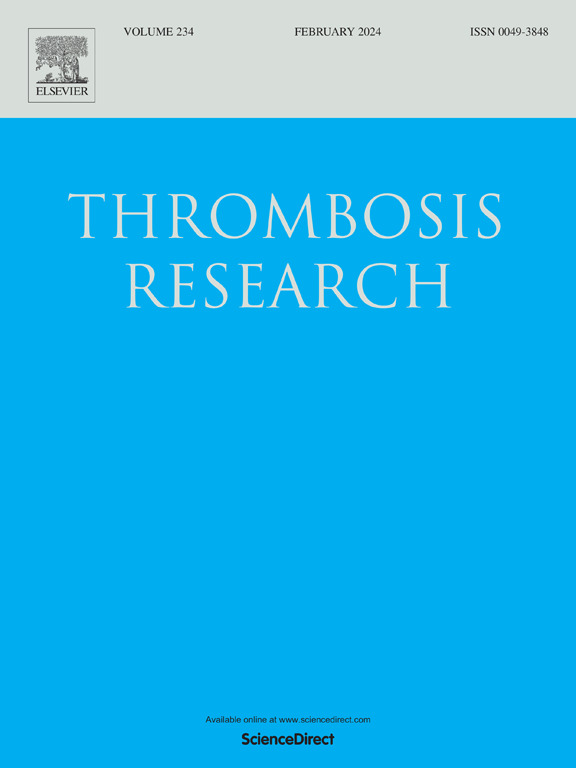Exploring the role of inflammation and proinflammatory proteins in coagulopathy during venovenous extracorporeal membrane oxygenation
IF 3.4
3区 医学
Q1 HEMATOLOGY
引用次数: 0
Abstract
Background
Coagulopathy frequently complicates venovenous extracorporeal membrane oxygenation (VV ECMO) procedures, yet its underlying mechanism remains elusive. This retrospective study aimed to identify factors contributing to coagulopathy during VV ECMO by analyzing clinical data and employing proteomic approaches. A prospective cohort was also examined for validation.
Methods
We retrospectively analyzed clinical data from 51 patients undergoing VV ECMO between January 2015 and April 2021, categorizing them into coagulopathy(n = 21), defined by elevated levels of D-dimer and decreased fibrinogen in plasma that were reversible by circuit exchange, and non-coagulopathy(n = 30) groups. Plasma samples collected on days 0–2(D1), days 3–5(D4), and days 6–8(D7) were subjected to proteomics and Luminex assay. Additionally, oxygenator fiber samples were collected from a prospective cohort between May 2022 and August 2022 for scanning electron microscopy.
Results
Inflammation emerged as a pivotal factor in coagulopathy development during VV ECMO, as evidenced by elevated interleukin-6 levels on D1 and increased leukocyte and neutrophil counts on D4. Proteomics analysis identified a significant elevation of S100A8 and S100A9 in the plasma of coagulopathy patients throughout VV ECMO, findings confirmed by Luminex assay. In the prospective cohort, thrombosis and leukocyte accumulation were observed on oxygenator fibers from coagulopathy patients, along with elevated levels of S100A8 and S100A9 in plasma.
Conclusions
Coagulopathy during VV ECMO is associated with heightened levels of proinflammatory proteins S100A8 and S100A9 in plasma, accompanied by leukocyte accumulation on oxygenator fibers. These findings emphasize the potential therapeutic target against coagulopathy during VV ECMO.
探讨炎症和促炎蛋白在静脉-静脉体外膜氧合过程中凝血障碍中的作用
背景:凝血病经常使静脉-静脉体外膜氧合(VV ECMO)手术复杂化,但其潜在机制尚不清楚。本回顾性研究旨在通过分析临床数据和采用蛋白质组学方法确定VV ECMO期间导致凝血功能障碍的因素。还对前瞻性队列进行了验证。方法回顾性分析2015年1月至2021年4月间51例VV ECMO患者的临床资料,将其分为凝血功能障碍组(n = 21)和非凝血功能障碍组(n = 30)。凝血功能障碍组的定义为血浆中d -二聚体水平升高和纤维蛋白原降低,可通过电路交换逆转。在第0-2天(D1)、第3-5天(D4)和第6-8天(D7)采集血浆样品进行蛋白质组学和Luminex检测。此外,从2022年5月至2022年8月期间的前瞻性队列中收集氧合器纤维样本进行扫描电子显微镜观察。结果炎症是VV ECMO期间凝血功能障碍发展的关键因素,D1上白细胞介素-6水平升高,D4上白细胞和中性粒细胞计数增加。蛋白质组学分析发现凝血功能障碍患者血浆中S100A8和S100A9在整个VV ECMO过程中显著升高,Luminex检测证实了这一发现。在前瞻性队列中,凝血病患者的氧合纤维上观察到血栓形成和白细胞积聚,同时血浆中S100A8和S100A9水平升高。结论VV ECMO期间的凝血功能障碍与血浆促炎蛋白S100A8和S100A9水平升高有关,并伴有白细胞在氧合纤维上的积聚。这些发现强调了在VV ECMO期间对抗凝血功能障碍的潜在治疗靶点。
本文章由计算机程序翻译,如有差异,请以英文原文为准。
求助全文
约1分钟内获得全文
求助全文
来源期刊

Thrombosis research
医学-外周血管病
CiteScore
14.60
自引率
4.00%
发文量
364
审稿时长
31 days
期刊介绍:
Thrombosis Research is an international journal dedicated to the swift dissemination of new information on thrombosis, hemostasis, and vascular biology, aimed at advancing both science and clinical care. The journal publishes peer-reviewed original research, reviews, editorials, opinions, and critiques, covering both basic and clinical studies. Priority is given to research that promises novel approaches in the diagnosis, therapy, prognosis, and prevention of thrombotic and hemorrhagic diseases.
 求助内容:
求助内容: 应助结果提醒方式:
应助结果提醒方式:


